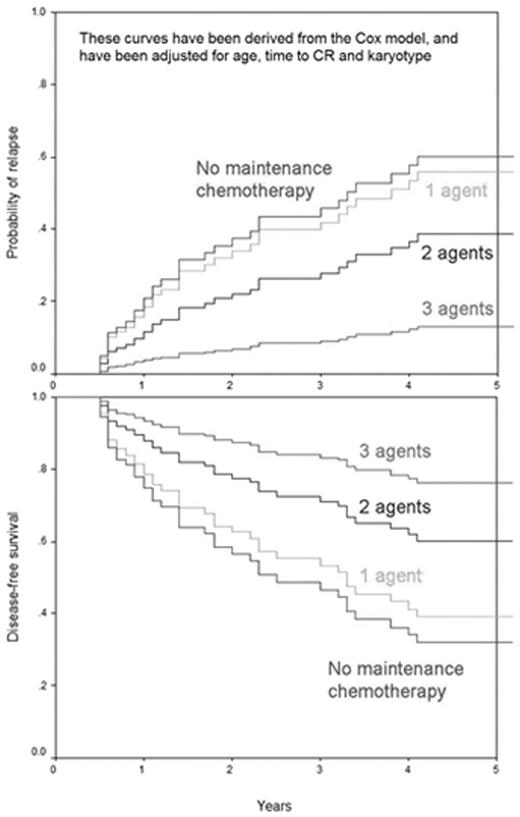Abstract
Results of autotransplantation in adult ALL are poor. MC, a component of standard ALL therapy, is usually not employed after autografting. 100 adults with ALL in CR1 received melphalan 110 mg/m2 with TBI followed by marrow (n=35) or melphalan 200 mg/m2 followed by blood stem cells (n=65) between 7/1984 and 2/2003. Daily 6-MP 25 mg was started when WBC and platelets reached 3 and 100 × 109/L respectively, and its dose increased gradually. Weekly methotrexate (MTX) 5 mg was added when the 6-MP dose reached 75 mg. Until 1995, monthly vincristine (1.4 mg/m2) and prednisolone (40 mg/m2 daily for a week) (VP) were given if 6-MP and MTX were not tolerated. After 1995, VP was given routinely. Starting MC was delayed only by inadequate counts, relapse, or medical problems that could get exacerbated. 6-MP and MTX doses were adjusted to maintain ANC >1 × 109/L. MC was stopped 2 y after starting 6-MP. 6 patients, all TBI and marrow recipients, died of toxicity (P=0.001). The 7-y cumulative incidence (CI) of relapse was 45%. The 7-y DFS and OS probabilities were 45% and 48%.
Age ≥30 y (49 patients), >4 wks to attain CR (20 patients), and karyotypes t(4;11) and t(9;22) (14 patients) were associated with higher relapse and lower DFS/OS. Patients with 0 (standard-risk; 42 patients), 1 (intermediate-risk; 36 patients), and 2–3 (high-risk; 22 patients) adverse features had 7-y CI of relapse of 19%, 53%, and 82% (P<0.0001), and 7-y DFS probabilities of 73%, 36%, and 7% (P<0.0001). 70 patients received 6-MP, 53 received MTX and 40 received VP. 22 patients received no MC at all, 14 received 1 agent, 43 received 2 agents, and 21 received 3 agents. MC did not result is any life-threatening toxicity. Amongst the 86 patients alive in CR at 4 months, the 7-year CI of relapse was 58%, 64%, 41%, and 23% for those receiving 0, 1, 2, and 3 MC agents (P=0.015). The corresponding 7-y DFS was 15%, 29%, 58%, and 61% (P=0.014). Patients getting MC had better outcome than those getting none. Patients getting 2/3 agents had better outcome than those getting 0/1 agents. MC intensity was an independent determinant of outcome in Cox analysis. The curves below show the effect of MC intensity.
When analyzed by disease risk, the benefit of MC was confined to patients with low- or intermediate-risk disease. While we cannot rule out the possibility that the ability to tolerate MC may have been a surrogate marker for a better-quality remission, the safety of post-transplant MC and its results are encouraging. We conclude that MC reduces relapse and improves DFS in non-high-risk ALL after autotransplantation, and this strategy should be incorporated as standard practice if an autograft is performed in ALL.
Author notes
Disclosure: No relevant conflicts of interest to declare.



This feature is available to Subscribers Only
Sign In or Create an Account Close Modal